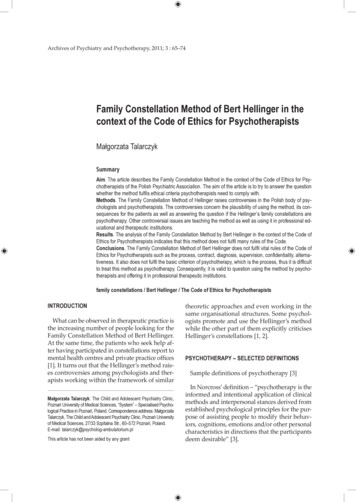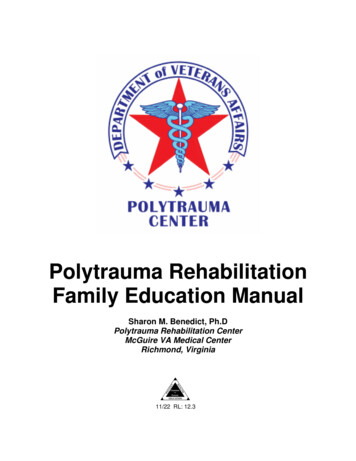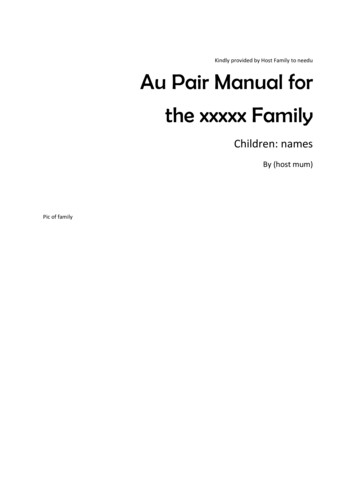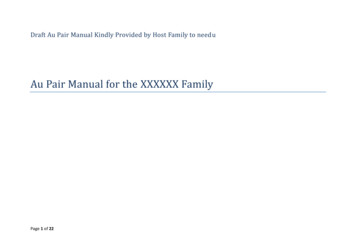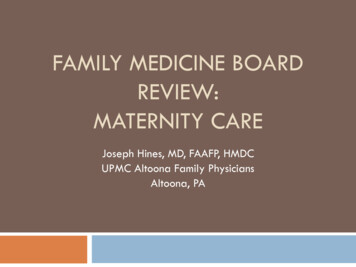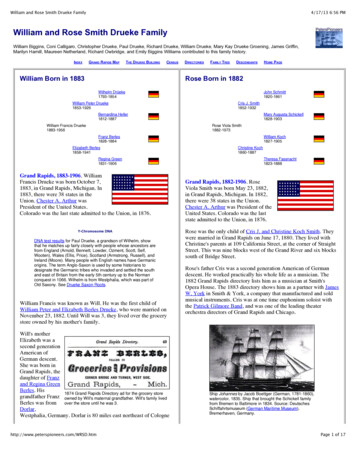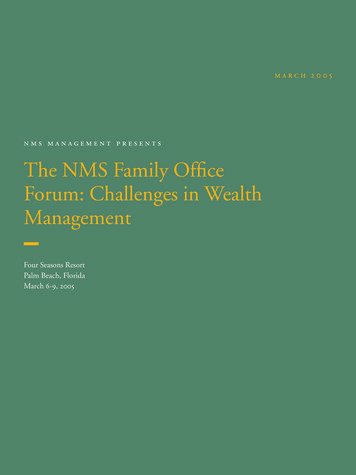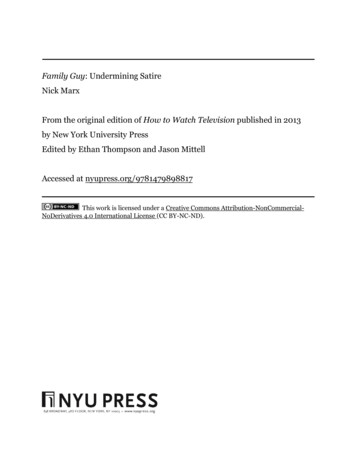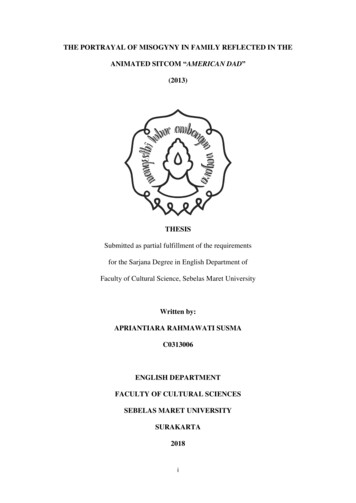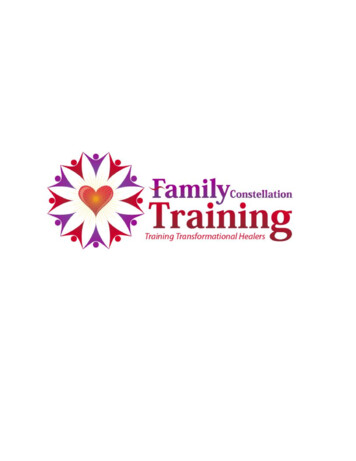
Transcription
Family Constellation Training Manualhttps://healingfamilytrauma.comTraining Manual Table of ContentsSection 2: History of Family Constellation Work42.1 The Development of Family Constellations by Bert Hellinger2.2 Hellinger in South Africa: a-story of the Zulu origins of Family ConstellationsSection 3: Facilitation Skills57133.1 Keys to Being a Great Family Constellations Facilitator3.2 Accepting One’s Parents: Being an Effective Facilitator3.3 Honoring the Client’s Family – Loyalty to All3.4 Hellinger on Becoming Whole14161719Section 4: Orders of Love214.1 Orders of Precedence4.2 Orders of Love- Right Relationship Between Parent and Child2226Section 5: The Importance Of Intake285.1 Introduction to Intake5.2 Jack’s Constellations Intro Talk5.3 Intake to Set-up5.4 Family History Considerations5.5 Hellinger - Start Small2931333537Section 6: Working in the Field386.1 Energy, order, reality6.2 Examples of Healing Statements6.3 Soul & Healing Statements6.4 Indicating Element6.5 Moving representatives in the field6.6 Proximity in the Field & Correct Order6.7 Representatives in the field: Where/what are they facing, what do they see?6.8 Bringing A Client Into The Field6.9 Ending a constellation6.10 Triage On An Incomplete ConstellationSection 7: Definitions and Concepts717.1 Definitions and ConceptsDefinitionsBlessings 2020 Jack Blackwell39414755596061646670727272Page 2
Family Constellation Training Role ReversalSupportBlind LoveLoyaltyBelongingWhat or who is excluded?“I do it in your place”FateGroup ConscienceFamily SoulIdentificationsConceptsVictim and PerpetratorForfeiting One’s PlaceAbortions and Lost ChildrenImpulse to join in deathDrug addiction and Death“I’m sorry”Interrupted MovementUnable to Connect with ParentsWho moves towards whom?Honoring Past Partners and RelationshipsDeath and LossLiberating a Wholeness in LoveIncestConstellation Work and Illness7.2 Christian/Jewish German/Jewish Healing in the Soul7.3 Miranda Constellation7.4 A child’s interrupted movement towards his mother or father7.5 Forfeiting One’s Place7.6 Bert Hellinger speaks on Forgiveness7.7 Thoughts on Perpetrators & Victims and the End of Revenge7.8 Primary, Secondary & Carried 89919292929598102106109110112116Section 8: Trauma and Resources8.1 Trauma Work and Family Constellations: Irreconcilable or Complementary?8.2 Family Constellation and Trauma Therapy8.3 Horse Constellation8.4 The Stories that Bind Us 2020 Jack BlackwellPage 3118119133149160
Family Constellation Training Manualhttps://healingfamilytrauma.comSection 2: History of Family Constellation Work 2020 Jack BlackwellPage 4
Family Constellation Training Manualhttps://healingfamilytrauma.com2.1 The Development of Family Constellations by Bert HellingerVivian, B. (2013). In the presence of many.Family Constellations, as the work was originally called, is the development ofBert Hellinger, a family and group therapist and self-described empiricist andphilosopher. Hellinger’s childhood and adolescence were against a background ofNational Socialism and subsequent war in Nazi Germany, which he survived in part as arebellious teenager, avoiding the Hitler Youth meetings, instead attending the thenillegal Catholic Youth organizations, and then as a 17-year old drafted soldier in theGerman army, captured by the allies and held in a prisoner of war camp in Belgium forthe rest of the war.His later life includes some 16 years as a Catholic priest and committedmissionary in South Africa working and living with the Zulu tribes, during which heengaged in an extensive training in interracial and ecumenical group dynamics. Duringhis time with the Zulu peoples he learned from their traditional culture respect for one’sancestors, viewing them as having influence on the present, providing strength, supportand wisdom that could be drawn on. He also learned the value of ritual from both thechurch and the tribal traditions of the Zulus, as providing ways of giving understanding,validation and acceptance.Subsequently he explored psychoanalysis, gestalt therapy, transactionalanalysis, primal therapy, hypnotherapy, NLP and family therapy, eventually leaving hisministry in the church. In the early 80’s Hellinger began to combine his group and familytherapy experience with the family re-construction work of Virginia Satir, who at the timewas working in Germany and Austria. Satir’s method of setting up families using groupmembers seems to have been catalytic in Hellinger’s move toward the work heeventually called Family Constellations.In the process of setting up group members as role-play representatives for aperson’s family (which had also been done by others in the field apart from Satir, mostnotably Jakob Moreno, who developed Psychodrama, and the German psychiatrist,Thea Schonfelder), Hellinger seems to have begun listening to what the representativeswere saying from a more existential and phenomenological base. By insisting on therepresentatives having little information about the person they represented, and thatthey refrain from taking up any sort of pose to indicate a certain attitude, Hellingerdemonstrated a different approach from Moreno’s psychodrama, and even Satir’s familyre-construction work. Hellinger thought that this helped the representatives in theconstellation connect with deeper and more hidden dynamics and existential dilemmas. 2020 Jack BlackwellPage 5
Family Constellation Training Manualhttps://healingfamilytrauma.comFrom his close observation of the subtle body and facial movements, impulsesand other reported experiences of the representatives, he developed an understandingof what he later called the Orders of Love: that, as in all things, there is a certain orderto relationships and living processes, particularly in closely bonded systems such asfamilies, and disturbance to this order, disruption or non-observance of the principles ofthis order, have effects on system members, sometimes over many generations. This isnot dissimilar to our understanding that if we go against the natural order in theenvironment, there will probably be consequences that may, over time, becomedevastating. We see this currently in our struggle with global warming, over-use ofchemicals, exploitation of the great forests of the world, contamination of water sourcesand so on. 2020 Jack BlackwellPage 6
Family Constellation Training Manualhttps://healingfamilytrauma.com2.2 Hellinger in South Africa: a-story of the Zulu origins of FamilyConstellationsBy Tanja Meyburgh, 2009Once upon a time in South Africa: Bert Hellinger in NatalI’ve often wondered why Bert Hellinger is so shy to talk of his time spent in SouthAfrica, or of the traditional African origins of family constellations. He has never beenforthcoming with information about his time spent here and has vowed that he will neverreturn. Why has he left it behind? Why would he not talk about a place where he livedfor 16 years? What did he give to this place, and what did he take?I first experienced constellations in 2002, and went on to train as a facilitator andco-found the first training here. I feel constantly engaged with the mystery of Hellinger’stime here through an ongoing need to honor the origins of my work. I have always feltthat family constellations connect me on a deeper level to South Africa and its traditionalpeople and cultures. How strange that I had to travel to Germany to study what feelsinherently African.The connection was obvious to me: the ancestral presence and the placing of theelements in the same way as the bones are thrown by the Sangoma (a traditionalAfrican ancestral healer). However, I felt there was something more: something thatwould shed light on the healing effect of family constellations.My search for understanding the historical origins in South Africa has taken mefrom an outer search in the midlands of Kwazulu Natal, to searching in the experienceand ideas of the local people, and finally to looking inwards to my own experience andwhat family constellations means to me. As I slowly weave my thoughts over the past 7years of working locally as a facilitator and trainer, I am finding a story to tell.All the information contained in this article is true to by best knowledge, and isbased on my own experiences. I have done my best to ask questions and present myfindings with respect to Bert Hellinger’s privacy and to honor his legacy. I am aware thatI am walking the fine line, and that my personal perspective is forever changing.On a mission: Christianity and the African Ancestral Tradition meet in the AfricanwildernessIt wasn’t easy to find the actual place. In fact, there were three places over the 16years. I literally stumbled into one, by following my intuition. Looking at the map & 2020 Jack BlackwellPage 7
Family Constellation Training Manualhttps://healingfamilytrauma.comsaying – let me start here. The huge red brick building is old and looks strange amongstthe rural hills dotted with round mud huts. The place is eerie and dilapidated, but hassigns of dedicated labour in a time where resources in the Christian church are few. Askeleton staff remains. I ask myself: what it was all for? What did the missions achieve?What must it have been like to arrive in the wild lands of Africa to save the local peoplefrom their “non-religious” ways?“Sawbona” – “I see you”. I am greeted by a young black priest. He fills me in ontheir history: Trappist monks arriving in the 1800’s, and later the missions that warnedthe locals to stay away from their own traditional beliefs in favor of the church. Today,but only since the 80’s, he is proud to report that the missions support all forms oftraditional beliefs that “promotes life” and healing. At the same time, every decisionmust still be passed through Rome, and “Rome takes a long time to decide”. It feels likea part of the past is standing still here. Some advances are evident in the way the priesthas decorated his private study: an eclectic mix of Catholic and African iconography,spears and shields, bibles, traditional African cloths, crosses, lions and pictures of thelily white virgin Mary.Hellinger arrived in South Africa in the conservative 1950’s. I met two grey-hairedEuropean priests who knew him. They don’t say much: “He was a very gifted man”, “Avery wise man” says the other. But, I sense there is more that is not said. I hear thatHellinger was “quite in the limelight” in his day and highly thought of by the Africanpriests. He was fluent in Zulu and did all the text translations of the liturgy, “bringing thefaith to the people in their own images and language”. He was responsible for building achurch at his rural parish. He was considered a “white raven” – someone out of theordinary. Someone special.But not all reports are positive. He was “intolerant of old-fashioned ideas, whichcaused some difficulties within the hierarchy”. He often spoke the “harsh truth”, “andwho is ready to hear the truth about yourselves”, said a sister. There were also harshwords, woundedness, and piercing analysis about the family life from which he came.I visit the seminary where Hellinger taught. It's inhabited, but feels deserted.Another huge red brick box on the top of the hill in the middle of no-where. Leadingdown from the looming façade is a little pathway into a magical overgrown garden.There, nestled amongst the African thorn bushes and flaming aloes, stands MotherMary. Mary in the jungle. There are signs of life, but no-body. Disturbed, I leave again.Finally, at the secondary school where Hellinger was allegedly principal for abrief period, I find animation – people going about their business. Steve Biko wasschooled here during the 60’s – and many other important figures in the blackconsciousness movement. Did they know Hellinger? I’m excited and brimming with 2020 Jack BlackwellPage 8
Family Constellation Training Manualhttps://healingfamilytrauma.comquestions: What was his role? When did he become headmaster? Who were hisstudents?I meet an old friend of his, who finds these questions unimportant, but shares hissoul and the deep love of Hellinger as priest and as man. I hear about the strengths andthe weaknesses. I get an image of the same split he has around him today – deeplyloving and hating of one man at the same time. Honey and poison. Once his confessionis over, we sit together on the veranda in the afternoon sun lost in our own thoughtsuntil it is time to leave.I feel a bit disappointed at the end of my journey that I did not find out more aboutthe Zulu influences and origins from “the source”, but do have a stronger “feeling” forHellinger the man and controversy surrounding him wherever he goes. I decide I needmore information from other sources and interview the African graduates of thefacilitator training for clues.To the horse’s mouth: South African constellation graduates’s thoughts onFamily Constellations and Traditional African cultureAfter talking to the Zulu graduates, the two most obvious connections of FamilyConstellations to their Traditional African beliefs are confirmed. Firstly, theacknowledgement that our ancestors are vital for our wellbeing:“The Zulu culture has a strong belief in Ancestors “Amadlozi” regardingconnecting with them to appease or release or ask for certain things. They are regardedas our guides and are composed of people we know who have left this planet.Constellating an unresolved issue is similar to doing a ceremony, talking to ancestor/sasking for forgiveness or connecting those who have left the planet in conflict.”“Africa’s sacred images are mainly ancestor spirits. God is the creator, the spiritforce responsible for all life on earth, including the ancestors, but he is too remote tohear the prayers of ordinary mortals. Dead ancestors, being spirits, communicate withGod, mediating between him and humanity”“The belief
Bert Hellinger, a family and group therapist and self-described empiricist and philosopher. Hellinger’s childhood and adolescence were against a background of National Socialism and subsequent war in Nazi Germany, which he survived in part as a rebellious teenager, avoiding the Hitler Youth meetings, instead attending the then illegal Catholic Youth organizations, and then as a 17-year old .
